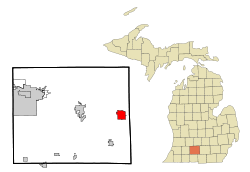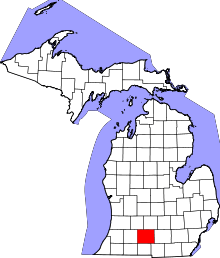Albion, Michigan
| Albion, Michigan | |
|---|---|
| City | |
 Location of Albion, Michigan | |
| Coordinates: 42°14′48″N 84°45′12″W / 42.24667°N 84.75333°WCoordinates: 42°14′48″N 84°45′12″W / 42.24667°N 84.75333°W | |
| Country | United States |
| State | Michigan |
| County | Calhoun |
| Area[1] | |
| • Total | 4.51 sq mi (11.68 km2) |
| • Land | 4.41 sq mi (11.42 km2) |
| • Water | 0.10 sq mi (0.26 km2) |
| Elevation | 951 ft (290 m) |
| Population (2010)[2] | |
| • Total | 8,616 |
| • Estimate (2012[3]) | 8,546 |
| • Density | 1,953.7/sq mi (754.3/km2) |
| Time zone | Eastern (EST) (UTC-5) |
| • Summer (DST) | EDT (UTC-4) |
| ZIP code | 49224 |
| Area code(s) | 517 |
| FIPS code | 26-00980[4] |
| GNIS feature ID | 0619906[5] |
Albion is a city in Calhoun County in the south central region of the Lower Peninsula of the U.S. state of Michigan. The population was 8,616[6] at the 2010 census and is part of the Battle Creek Metropolitan Statistical Area. From the time that the earliest English-speaking settlers arrived, the area has also been known as The Forks, because it is situated at the confluence of the north and south branches of the Kalamazoo River. The Festival of the Forks has been held annually since 1967 to celebrate Albion's ethnic heritage.
The presence of several major manufacturers since the 19th century has given Albion the reputation of a factory town. This has changed with the closure of several manufacturers, and Albion's culture is changing to that of a college town with a strong interest in technology and sustainability issues. Albion College is a private liberal arts college with a student population of about 1,750. Albion is a sister city with Noisy-le-Roi, France.
History
The first European-American settler, Tenney Peabody, arrived in 1833 along with his brother-in-law Charles Blanchard, and a young man named Clark Dowling. Peabody's family followed soon after. In 1835, the Albion Company, a land development company formed by Jesse Crowell, platted a village and Peabody's wife was asked to name the settlement. She considered the name "Peabodyville", but "Albion" was selected instead, after the former residence of Jesse Crowell. Crowell became the first postmaster in 1838. Albion incorporated as a village in 1855 and as a city in 1885.[7][8]
In 1835, Methodist Episcopal settlers established Albion College, which was known by a few other names before 1861 when the college was fully authorized to confer four-year degrees on both men and women. The first classes were held in Albion in 1843.
The forks of the Kalamazoo River provided power for mills, and Albion quickly became a mill town as well as an agricultural market. A railroad line arrived in 1852, fostering the development of other industries.
In 1973 Albion was named an All-America City by the National Civic League. It celebrated winning the award on May 15, 1974 when the Governor of Michigan, William Milliken, and many dignitaries came to town. However, in 1975 the closure of a major factory cut the celebration short and new challenges were created overnight.
Since that time citizens have mobilized, with support from the Albion Community Foundation founded in 1968, and the Albion Volunteer Service Organization, founded in the 1980s with support from Albion College, to address the challenge of diminishing economic opportunity.

Key to the City Honor Bestowed:
- 1964: Aunt Jemima visited Albion on January 25.[9]
- 1960s: Ann Landers was presented with a key upon her visit to Starr Commonwealth for Boys.[9]
Law and government
Albion has a Council-Manager form of government. City residents elect a Mayor and City Council members from six districts. The council in turn selects a City Manager to handle day-to-day affairs of the city. The mayor presides over and is a voting member of the council. Council members are elected to four-year terms, staggered every two years. A mayor is elected every two years.
Geography
According to the United States Census Bureau, the city has a total area of 4.51 square miles (11.68 km2), of which 4.41 square miles (11.42 km2) is land and 0.10 square miles (0.26 km2) is water.[1] Albion is positioned 42.24 degrees north of the equator and 84.75 degrees west of the prime meridian.
Climate
| Climate data for Albion | |||||||||||||
|---|---|---|---|---|---|---|---|---|---|---|---|---|---|
| Month | Jan | Feb | Mar | Apr | May | Jun | Jul | Aug | Sep | Oct | Nov | Dec | Year |
| Average high °F (°C) | 33.6 (0.9) |
31.8 (−0.1) |
41.6 (5.3) |
55.5 (13.1) |
70.0 (21.1) |
79.8 (26.6) |
85.6 (29.8) |
82.3 (27.9) |
74.2 (23.4) |
60.5 (15.8) |
44.0 (6.7) |
36.5 (2.5) |
57.95 (14.42) |
| Average low °F (°C) | 19.8 (−6.8) |
17.2 (−8.2) |
26.6 (−3) |
38.3 (3.5) |
49.8 (9.9) |
59.6 (15.3) |
63.8 (17.7) |
61.3 (16.3) |
54.6 (12.6) |
43.0 (6.1) |
31.0 (−0.6) |
24.8 (−4) |
40.82 (4.9) |
| Average precipitation inches (mm) | 2.0 (51) |
1.7 (43) |
2.4 (61) |
3.2 (81) |
3.7 (94) |
3.7 (94) |
3.3 (84) |
3.1 (79) |
3.3 (84) |
2.7 (69) |
2.6 (66) |
2.3 (58) |
33.9 (861) |
| Source: Weatherbase [10] | |||||||||||||
Demographics
| Historical population | |||
|---|---|---|---|
| Census | Pop. | %± | |
| 1850 | 881 | — | |
| 1880 | 2,716 | — | |
| 1890 | 3,763 | 38.5% | |
| 1900 | 4,519 | 20.1% | |
| 1910 | 5,833 | 29.1% | |
| 1920 | 8,354 | 43.2% | |
| 1930 | 8,324 | −0.4% | |
| 1940 | 8,345 | 0.3% | |
| 1950 | 10,406 | 24.7% | |
| 1960 | 12,749 | 22.5% | |
| 1970 | 12,112 | −5.0% | |
| 1980 | 11,059 | −8.7% | |
| 1990 | 10,066 | −9.0% | |
| 2000 | 9,144 | −9.2% | |
| 2010 | 8,616 | −5.8% | |
| Est. 2015 | 8,229 | [11] | −4.5% |
| Source: Census Bureau. Census 1960- 2000, 2010. | |||
2010 population by gender/age
| Male | 4,013 | 46.6% |
| Female | 4,603 | 53.4% |
| Under 18 | 1,872 | 21.7% |
| 18 and over | 6,744 | 78.3% |
| 20-24 | 1,364 | 15.8% |
| 25-34 | 842 | 9.8% |
| 35-49 | 1,251 | 14.5% |
| 50-64 | 1,368 | 15.9% |
| 65 and over | 1,124 | 13.0% |
2010 population by ethnicity
| Hispanic or Latino | 500 | 5.8% |
| Non Hispanic or Latino | 8,116 | 94.2% |
2010 population by race
| White | 5,477 | 63.6% |
| African American | 2,579 | 29.9% |
| Asian | 91 | 1.1% |
| American Indian and Alaska Native | 29 | 0.3% |
| Native Hawaiian and Other Pacific Islander | 17 | 0.2% |
| Other | 90 | 1.0% |
| Identified by two or more | 333 | 3.9% |
Transportation
Rail
Amtrak, the national passenger rail system, provides daily service to Albion, operating its Wolverine both directions between Chicago, Illinois and Pontiac, Michigan via Detroit.
Bus
Greyhound Lines provides daily intercity city bus service to Albion between Chicago, Illinois and Detroit.
Notable people
- M. F. K. Fisher, food writer, born in Albion
- Frank Joranko, football player and coach for Albion College
- Martin Wells Knapp, American Methodist evangelist who founded the Pilgrim Holiness Church and God's Bible School and College, born in Albion.
- Bill Laswell, jazz bassist, record producer and record label owner; born in Albion
- Jerome D. Mack, banker, director of Las Vegas hotels Riviera and Dunes, founder of University of Nevada, Las Vegas; born in Albion
- Deacon McGuire, professional baseball player for 26 seasons, lived in Albion
- Gary Lee Nelson, composer, pioneer in electronic and computer music; grew up in Albion Gary Lee Nelson's home page
- Jack Vaughn, Assistant Secretary of State, Ambassador to Panama and Colombia, and Director of the Peace Corps (1966-1969); grew up in Albion
See also
References
- 1 2 "US Gazetteer files 2010". United States Census Bureau. Archived from the original on 2012-01-24. Retrieved 2012-11-25.
- ↑ "American FactFinder". United States Census Bureau. Retrieved 2012-11-25.
- ↑ "Population Estimates". United States Census Bureau. Archived from the original on 2013-06-17. Retrieved 2013-06-03.
- ↑ "American FactFinder". United States Census Bureau. Archived from the original on 2013-09-11. Retrieved 2008-01-31.
- ↑ "US Board on Geographic Names". United States Geological Survey. 2007-10-25. Retrieved 2008-01-31.
- ↑ "2010 Census Interactive Population Search: Albion, MI". 2010.census.gov. Retrieved 2012-09-14.
- ↑ "Festival of the Forks", Frank Passic, Morning Star, September 10, 2000, pg. 9
- ↑ "The Passing Scene", Frank Passic, Morning Star, September 9, 2001, pg. 3
- 1 2 "The Key To The City". Albionmich.com. Retrieved 2012-09-14.
- ↑ "Weatherbase: Historical Weather for Albion, Michigan". Weatherbase. 2011. Retrieved on November 24, 2011.
- ↑ "Annual Estimates of the Resident Population for Incorporated Places: April 1, 2010 to July 1, 2015". Retrieved July 2, 2016.
External links
| Wikimedia Commons has media related to Albion, Michigan. |
| Wikisource has the text of a 1921 Collier's Encyclopedia article about Albion, Michigan. |
- Albion City Information Page
- Albion District Library
- Albion Michigan Home Page
- Historical Albion Michigan
- Festival of the Forks – Albion's annual music and food festival by the forks of the Kalamazoo River
- The Greater Albion Chamber of Commerce
- Albion Michigan Community Foundation – For Good. For Ever.
